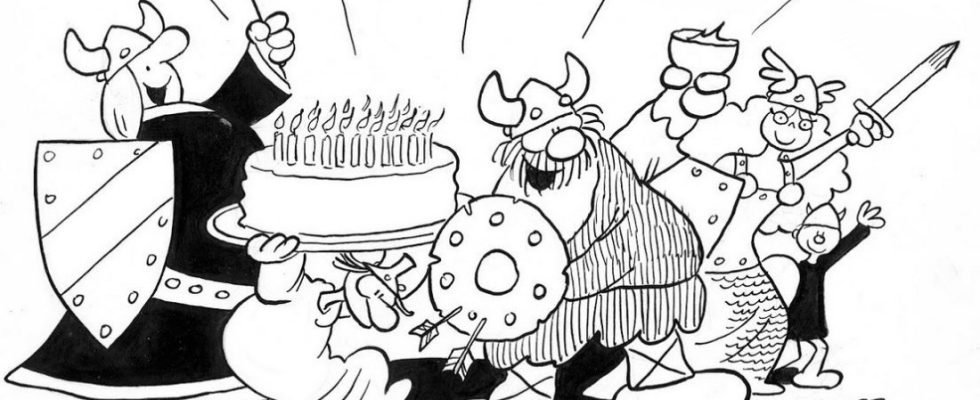He is considered a feared conqueror. For him, however, robbing and pillaging is just a job with which he feeds his family of four. His true passion: food. He also likes to hang out in his favorite pub. On the other hand, he can be hunted down with housework, and he doesn’t like it when his mother-in-law comes to visit either. As you can see, looting aside, Hägar the Terrible could be our neighbor.
And that may explain why the bearded Viking, who walks around in a dirty bearskin, had tremendous success after its premiere on February 4, 1973 and is still appearing in more than 1900 newspapers today. That means 50 years after he moved his army to the wrong castle in the very first strip. The reason? Hägar had gotten the house number wrong.
If you are a Hägar fan and write down Karolinenplatz 3 in Munich as your address, this should not happen to you. Because there, in the Amerikahaus, as part of the Munich Comic Festival starting on June 8, under the title “Yes, we kan” Hägar’s fiftieth birthday was celebrated. At least that was the original idea of curator Michael Kompa, who, in collaboration with author Timur Vermes and comics historian Alexander Braun, created an exhibition on “Newspaper comics from the Yellow Kid to Hägar and Kangaroo Comics”. Hägar is still prominent, with many original drawings by Hägar inventor Dik Browne as well as works by current Hägar artist Gary Hallgren.
Other works by Hallgren can also be seen. Including a cover of the underground comic magazine “Air Pirates” from 1971, which shows Minnie Mouse as a prostitute. Hallgren never finished the cover, it never came out. Because the “Air Pirates” makers were at the time in a year-long legal dispute with the Disney Company due to similarly nasty parodies. Hägar father Dik Browne also has earlier work from the series “Hi & Lois” with which he had his breakthrough. In 1988, a year before his death, he passed the two series on to his sons Chance and Chris Browne. On June 8th, Chance Browne is paired with Gary Hallgren guest at the America House.
The first comic character: Richard Felton Outcault wrote the lines of text on the nightgown of his bald “Yellow Kid”.
(Photo: Richard Felton Outcault)
Such an intra-family handover was quite common in the newspaper comics trade, the history of which the highly worth seeing exhibition traces back to May 5, 1895. That day, the “Yellow Kid” had in the New York World his first appearance. The bald-headed street kid in the yellow nightgown, drawn by Richard Felton Outcault, was still active in a hidden object picture and not yet in the panels we know today. And Outcault had written his lyrics on the nightgown. What made the “Kid” the first comic book character: It recurred reliably in the newspaper. That made it a role model and the first comic book superstar.
It was thanks to Joseph Pulitzer. Because the famous publisher didn’t just invent the tabloid press. He first included the “Funny Pages” in his New York World newspaper in 1892. The new entertainment format hit like a bomb. The picture jokes became the first newspaper comics and these became a lucrative business, which soon led to bitter competition between publishers. For example, William Randolph Hearst soon bought Pulitzer’s entire comic team, with the result that “Yellow Kid” appeared in two newspapers at times. It was similar with the “Katzenjammer Kids”, which the German economic refugee Rudolph Dirks invented for Hearst.
The German economic refugee Rudolph Dirks invented “The Katzenjammer Kids” for Randolph Hearst.
(Photo: Rudoph Dirks)
What makes the series about two Radau brothers, intended as a “Max and Moritz” copy, historical, in addition to its long running time until 2006, is the fact that Dirks used speech bubbles for the first time. Innovations like this have been around all the time. And it’s amazing to see from the many original pages how quickly comics have developed as an art form. For example, in Little Nemo in Slumberland, the great Winsor McKay invented surrealism 20 years before surrealism. In series like “Polly and Her Pals” Expressionism found its way early on. From 1913 onwards, George Herriman threw all conventions out of whack with “Krazy Kat”. And new genres such as adventure and superhero comics established themselves.
In Germany you didn’t get much of it. Because the newspaper comic could never gain a foothold here. Which is why the “Peanuts” or “Garfield”, which are also represented in the exhibition, are only known here from books, magazines or television. Also significant: The only two German newspaper strips presented extensively, Volkert Reiche’s FAZ series “Strizz” and the “Kangaroo Comics” by Marc-Uwe Kling and Bernd Kissel, which were created during Corona, date from the past 20 years. And before? There were a few experiments with artists like Loriot, otherwise you bought strips from America if needed. The country where comics were a capitalist mass medium from the start, but also great art from an early stage.
“Yes, we käng”, until September 30th, Amerikahaus Munich, Karolinenpl. 3, www. Amerikahaus.de

